The wine bag market is experiencing consistent expansion, driven by increasing global wine consumption and evolving packaging preferences among both consumers and retailers. Industry publications and packaging innovation forums have reported a growing inclination toward sustainable, stylish, and functional wine transportation solutions, especially within gifting, retail, and hospitality environments.
Wine producers and distributors have responded by adopting differentiated packaging formats such as reusable and fabric-based wine bags to enhance product appeal and reduce environmental impact. The rise of premiumization trends in alcoholic beverages has further stimulated demand for attractive and protective packaging formats. Retailers have also expanded their merchandising of reusable wine carriers, aligning with broader sustainability goals and waste reduction efforts.
In emerging economies, increasing disposable income and urban retail penetration have accelerated the uptake of wine accessories, including premium wine bags. Looking ahead, market growth is anticipated to be led by fabric materials due to eco-conscious appeal, reusable formats due to their value and durability, and single bottle designs as the preferred choice for individual gifting and retail presentation.
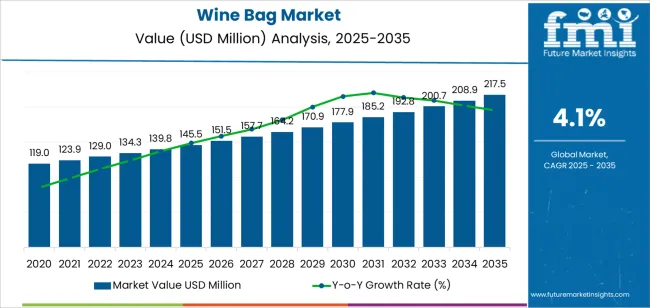
| Metric | Value |
|---|---|
| Wine Bag Market Estimated Value in (2025 E) | USD 145.5 million |
| Wine Bag Market Forecast Value in (2035 F) | USD 217.5 million |
| Forecast CAGR (2025 to 2035) | 4.1% |
The market is segmented by Material, Product Type, and Capacity and region. By Material, the market is divided into Fabric Bags, Plastic Bags, and Paper Bags. In terms of Product Type, the market is classified into Reusable Wine Bags and Disposable Wine Bags. Based on Capacity, the market is segmented into Single Bottle Wine Bags and Multi Bottle Wine Bags. Regionally, the market is classified into North America, Latin America, Western Europe, Eastern Europe, Balkan & Baltic Countries, Russia & Belarus, Central Asia, East Asia, South Asia & Pacific, and the Middle East & Africa.
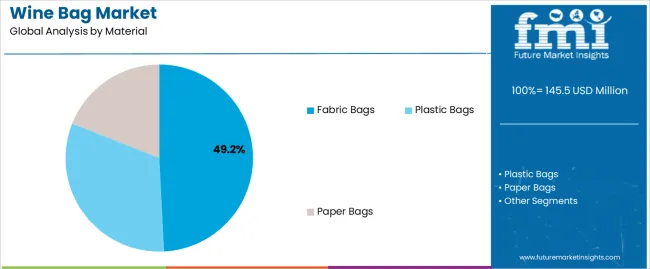
The Fabric Bags segment is projected to contribute 49.20% of the wine bag market revenue in 2025, making it the leading material category. Growth in this segment has been driven by increasing consumer preference for eco-friendly and reusable packaging alternatives that align with sustainability objectives.
Fabric materials, including jute, cotton, and canvas, have been favored by retailers and gift packaging companies for their biodegradable nature and aesthetic flexibility. Branding opportunities on fabric wine bags have also been leveraged by wineries and retailers seeking customized packaging solutions that enhance product visibility.
In addition, the perceived value and durability of fabric bags have made them a popular choice for repeat use, particularly in markets where plastic bans and eco-conscious legislation are in effect. As the demand for sustainable packaging continues to shape consumer and brand behavior, the Fabric Bags segment is expected to retain its leadership position.

The Reusable Wine Bags segment is projected to account for 63.0% of the wine bag market revenue in 2025, securing its place as the dominant product type. The segment’s growth has been fueled by heightened environmental awareness and consumer demand for waste-reducing alternatives to single-use packaging.
Retailers and wine shops have increasingly promoted reusable bags as part of their green initiatives, often offering them as purchase incentives or value-added packaging. Consumers have shown a strong preference for wine bags that offer longevity, aesthetic appeal, and the ability to serve multiple purposes.
Reusable designs have also found favor in hospitality and event settings, where presentation and functionality are essential. The integration of stylish elements such as handles, compartments, and customizable prints has further enhanced the appeal of reusable wine bags. As sustainable packaging gains traction across all retail segments, reusable wine bags are expected to dominate the product landscape by offering both functional and environmental advantages.
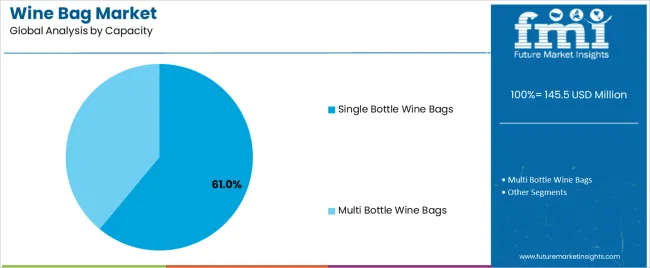
The Single Bottle Wine Bags segment is projected to contribute 61.0% of the wine bag market revenue in 2025, leading the capacity segment. Growth in this category has been driven by consumer behavior patterns favoring single-bottle gifting and presentation formats, particularly in retail, hospitality, and celebratory contexts.
Packaging reports and retail sales data have indicated strong adoption of single bottle bags for their ease of handling, compact size, and aesthetic presentation. Wine retailers have prioritized single bottle packaging options to enhance shelf appeal and facilitate impulse purchases, especially during peak gifting seasons.
Additionally, hospitality venues have adopted single bottle wine bags for room service, minibar presentation, and takeaway services, supporting their widespread use. As personalization and customization trends gain traction in packaging, single bottle formats offer a canvas for brand messaging and promotional campaigns. The segment’s sustained demand is expected to be reinforced by its practicality, visual appeal, and alignment with common purchasing patterns.
Wine bags often boast aesthetic appeal, adding a touch of elegance and sophistication to the act of gifting or transporting wine. This focus on aesthetics aligns perfectly with the growing consumer preference for premiumization and creating a complete sensory experience.
The wine bag industry is poised for significant growth due to a combination of demographic shifts, evolving lifestyles, and the increasing popularity of wine.
As the global population expands and urban living becomes more commonplace, the demand for convenient, stylish, and space-saving wine carrying solutions is anticipated to continue to rise, propelling the wine bag market to new heights.
The market is experiencing a sweet spot, compelled by a confluence of factors that benefit both wineries and consumers. A key aspect of the market growth in urban areas is the cost-effectiveness of wine bags for wineries. Compared to traditional packing materials like wooden boxes, wine bags offer a significant cost saving on packaging.
Such endeavours translate directly to increased profitability for wineries, allowing them to invest in higher quality grapes production processes or even lower their bottle prices for consumers.
This cost advantage is particularly relevant in a market where the popularity of alcoholic beverages is on the rise. Consumers are increasingly enjoying wine, not just domestically but also internationally, leading to a surge in wine exports and imports.
The burgeoning demand for wine crafted a perfect storm for the wine bag market. As international brands become more accessible to consumers worldwide, the need for secure and stylish transportation of wine bottles becomes paramount. Wine bags offer a solution that is both practical and aesthetically pleasing.
The lightweight and compact design makes them ideal for international shipping, reducing transportation costs for wineries and distributors. For wine enthusiasts, wine bags provide a convenient and eco-friendly way to carry their purchases, often featuring reusable materials or even recycled content.
Few winemakers have taken the opportunity to design wine bags that can be customized with brand logos, designs, or promotional messages.
This allows wineries to create a cohesive brand experience, extending their brand identity beyond the bottle itself. In a market increasingly focused on premiumization and making a complete sensory experience for consumers, this ability to tell a brand story through packaging is invaluable.
The wine bag industry is thriving due to its ability to offer a win-win situation for both wineries and consumers. Cost-effectiveness for producers, coupled with convenience and style for consumers, is driving the market forward.
As the global love affair with wine continues to grow and international trade flourishes, expect the wine bag market to remain a vital part of the wine industry, ensuring a smooth and stylish journey for next bottle of wine.
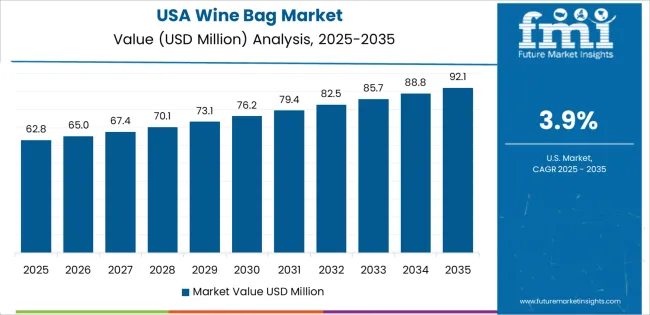
The wine industry of the United States is experiencing a robust period, fueled by surging domestic production, particularly from renowned regions such as Napa Valley and Sonoma. A well-established distribution network catering specifically to premium beverages like wine accompanies the demand growth.
Major players like Republic National Distributors (RNDC), Southern Glazer's Wine and Spirits, and Breakthru Beverage Group have established extensive networks across the United States, ensuring efficient delivery of wines from wineries to retailers and restaurants.
This robust distribution system, coupled with rising domestic production, creates a strong demand for stylish and practical wine-carrying solutions.
Wine bags, with their affordability and convenience, are perfectly positioned to capitalize on this flourishing market, offering wineries a cost-effective way to package their products and Americans a convenient way to transport their purchases.
China’s beverage industry is experiencing growth, positively impacting the wine bag industry due to the development of domestic beverage production led by established companies like Yanjing Beer and Mengniu Dairy.
Chinese consumers are increasingly drawn to sustainable packaging solutions. Wine bags, with their lightweight construction and often-recycled content, perfectly align with this eco-conscious trend. The focus on eco-friendly packaging resonates with major international beverage companies entering the Chinese market.
Giants like Diageo and AB InBev are focusing on sustainability in their global operations, making wine bags an attractive option for their Chinese offerings. As the Chinese beverage industry continues to grow, the wine bag industry is expected to benefit significantly, offering stylish and sustainable solutions for producers and consumers.
Numerous social and economic elements are combined to create a powerful rise in the alcohol sector in India. Growing numbers of people are becoming more affluent due to rapid urbanization, which is enhancing their preference for expensive drinks like wine.
Another factor is the impact of Western culture, with wine becoming more and more common for festivals and social events.
A major opportunity exists in the wine bags industry because of the growing demand for wine. Prominent wineries in India, such as Fratelli Vineyards and Moet Hennessy India, who represent global brands like Chandon, may take use of wine bags' cost and practicality to connect with this growing consumer base in India.
Wine bags are a fashionable and environmentally responsible substitute for conventional packaging materials, which is ideal given Indian customers' rising environmental conscience. The demand for wine bags is expected to increase significantly as India's passion for wine continues to flourish, benefiting both customers and wineries.
Wine bag sales are expected to increase their present value, with a notable move towards fabric material alternatives. A global trend towards sustainable packaging solutions drives this rise.
Reusable cloth wine bags are becoming more and more popular as the industry looks for plastic substitutes. In an effort to appeal to customers who care about the environment, businesses like Winc (United States) and Naked Wines (United Kingdom) already include reusable fabric tote bags in their wine club subscription packages.
Beyond being environmentally friendly, cloth bags have a high-end appearance. Luxurious wine labels, such as Vega Sicilia from Spain and Opus One from California, have started adding classy cloth wine bags to their packaging to increase the perceived worth of their wines.
Fabric bags are positioned as a game-changer in the wine bag industry due to their combination of environmental responsibility and premium appearance. They also perfectly match the changing demands of luxury companies and eco-conscious consumers.
Multi-bottle alternatives are gaining traction in the wine bag industry. These bags, available from businesses like Rapak (Canada) and Bevcorp (USA), offer an affordable means of carrying several wine bottles at once.
Wineries trying to cut expenses on packaging, such as Castel Winery in France and Concha y Toro in Chile, find this to be very appealing. Customers are affected by the convenience factor. Because multi-bottle wine bags are so convenient for giving or taking wine to events, the multi bottle wine bag industry segment is expected to dominate the market by 2035.
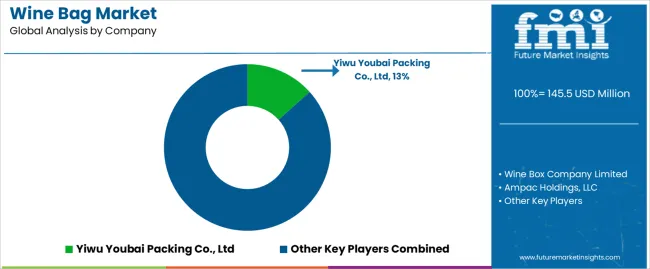
The wine bag market is witnessing a dynamic shift as key players strategically maneuver to capture a larger share. To meet the burgeoning demand for stylish and sustainable wine carriers, established companies are actively pursuing growth strategies.
Mergers and acquisitions are emerging as a popular tactic. This allows them to expand their resource pool, acquiring new manufacturing capabilities or design expertise. For instance, a major wine bag producer might acquire a smaller company known for its innovative, eco-friendly materials. This combined entity would be well-positioned to offer a wider range of products, catering to the diverse needs of wineries and consumers.
Furthermore, key players are investing in facility upgrades to enhance their production capacity and meet the growing market demand. By adopting these strategic approaches, the wine bag industry is poised for continued growth, with companies offering increasingly sophisticated and sustainable solutions for wine transportation.
In terms of material, the market encompasses paper bags, plastic bags, and fabric bags.
The industry is bifurcated into reusable wine bags and disposable wine bags, based on the product type.
Based on the capacity of the bags, the industry is forked into single bottle wine bags and multi bottle wine bags.
As per region, the industry is divided into North America, Latin America, Europe, Asia-Pacific, and the Middle East and Africa.
The global wine bag market is estimated to be valued at USD 145.5 million in 2025.
The market size for the wine bag market is projected to reach USD 217.5 million by 2035.
The wine bag market is expected to grow at a 4.1% CAGR between 2025 and 2035.
The key product types in wine bag market are fabric bags, plastic bags and paper bags.
In terms of product type, reusable wine bags segment to command 63.0% share in the wine bag market in 2025.






Full Research Suite comprises of:
Market outlook & trends analysis
Interviews & case studies
Strategic recommendations
Vendor profiles & capabilities analysis
5-year forecasts
8 regions and 60+ country-level data splits
Market segment data splits
12 months of continuous data updates
DELIVERED AS:
PDF EXCEL ONLINE
Competitive Overview of Wine Bag Companies
Reusable Wine Bags Market Size and Share Forecast Outlook 2025 to 2035
Industry Share Analysis for Reusable Wine Bags Companies
Wine Cork Market Size and Share Forecast Outlook 2025 to 2035
Wine Barrel Market Size and Share Forecast Outlook 2025 to 2035
Wine Cellar Market Size and Share Forecast Outlook 2025 to 2035
Wine Enzymes Market Analysis Size Share and Forecast Outlook 2025 to 2035
Wine Box Market Size and Share Forecast Outlook 2025 to 2035
Wine Fining Agent Market Size and Share Forecast Outlook 2025 to 2035
Wine, Scotch, and Whiskey Barrels Market Size and Share Forecast Outlook 2025 to 2035
Wine Totes Packaging Market Size and Share Forecast Outlook 2025 to 2035
Wine Fermentation Equipment Market Size and Share Forecast Outlook 2025 to 2035
Wine Processing Equipment Market Size and Share Forecast Outlook 2025 to 2035
Wine Racks Market Size and Share Forecast Outlook 2025 to 2035
Wine Filling Machine Market Size and Share Forecast Outlook 2025 to 2035
Wine Bottle Sterilizer Market Size and Share Forecast Outlook 2025 to 2035
Wine Extract Market Size and Share Forecast Outlook 2025 to 2035
Wine Market Analysis - Size, Share, and Forecast Outlook 2025 to 2035
Wine Tourism Market Analysis - Size, Share, and Forecast Outlook 2025 to 2035
Wine Destemmer Market - Growth & Demand 2025 to 2035

Thank you!
You will receive an email from our Business Development Manager. Please be sure to check your SPAM/JUNK folder too.
Chat With
MaRIA